Physical Address
304 North Cardinal St.
Dorchester Center, MA 02124
All neurostimulators require an energy source to generate the electric fields which modulate the nervous system. The choice of technologies to power neurostimulators has a greater impact on the device design than any other choice. The use of an implanted battery and type of battery (rechargeable or nonrechargeable) can not only impact the volume of the device but also how the patient uses it. Inductively coupling power through skin provides a means to power devices but at the cost of wearing an external coil held in place over the implant during its use. This approach may be acceptable to patients who only require stimulation on an intermittent basis but becomes less acceptable for applications which require continuous stimulation. Here we survey the technology which has been developed.
Over the past decade, a number of important advances in Neuromodulation therapies have been achieved. New stimulation waveforms have resulted in increases in efficacy for spinal cord stimulation (SCS) [ , ] and neuromodulation has been applied to many new therapeutic applications. Numerous applications have been approved and are in routine clinical use. These devices are being used to treat chronic neuropathic pain, incontinence [ ], symptoms of Parkinson's disease [ ], and epilepsy [ ] to name a few. Trials are underway assessing the efficacy for the treatment and alleviation of symptoms of Alzheimer's and even some diseases which have only recently been discovered to be modulated via neural pathways such as rheumatoid arthritis.
At present there are only a few technologies used for powering neurostimulators. Primary cell devices employ large capacity batteries that are slowly depleted and cannot be recharged, they have the advantage that they require no interaction with the recipient until depletion at which time they need to be surgically replaced. Rechargeable batteries can be periodically recharged and as a result can deliver power to much more energy hungry stimulation algorithms and still provide an acceptable service life for the implanted device. Charging is achieved through transcutaneous inductive links, the design of which are optimised to minimise the charging time and avoid any side effects. The last technique is do away with the battery in the implant and rely on powering the device through transcutaneous links. Some neurostimulators, such as cochlear implants, do not have implanted power sources and use transcutaneous links whenever they are operated, thereby achieving a service life equal to the patient's entire lifetime.
Some of the new neuromodulation technology and stimulation algorithms are only possible with energy dense and efficient power sources. There have been significant improvements in outcomes reported from recent clinical trials for new stimulation paradigms for SCS. High-frequency stimulation (10 kHz) of the spinal cord has demonstrated improved outcomes, but at the cost of shorter recharge intervals [ ]. Feedback controlled SCS devices use low stimulus power but require additional power to capture the evoked response waveform and use it in a feedback loop. Power requirements have been increasing with successive generations of devices, but power sources are changing more slowly. Fortunately, improvements in silicon fabrication techniques will allow future clinical improvements to be accommodated while maintaining acceptable battery life.
Battery life can always be improved by the use of a bigger battery, but this will make the device more invasive and thus less competitive. Improved chemistries that have higher energy density can also be considered but this requires additional R&D, engineering and testing. Improved design techniques can improve battery life without requiring new chemistries or sacrificing device size but taking time and expense. Improved design techniques can lead to the addition of new functions such as evoked compound action potential (ECAP) measurement and continuous therapeutic monitoring and these increase requirements on the power source. In practical situations, commercial stimulator designs reach a point where all requirements are met and patients need timely therapy so the design is frozen. This leaves opportunities for future improvements.
The power architecture of a neuromodulation system is illustrated in Fig. 10.1 . Items drawn with broken lines may not be present in some systems. To provide stimulation, the battery voltage must often be transformed to a suitable value before powering a stimulator which generates the stimulus waveforms required to provide therapy to the patient. For example, many SCS stimulators are powered by rechargeable lithium cells providing around 3.7 V, while the voltage required for stimulation may be as high as 15 V. A neurostimulator also performs ancillary functions, such as communicating with a remote control, gathering, and storing diagnostic information, providing feedback control in ECAP-controlled stimulators etcetera.
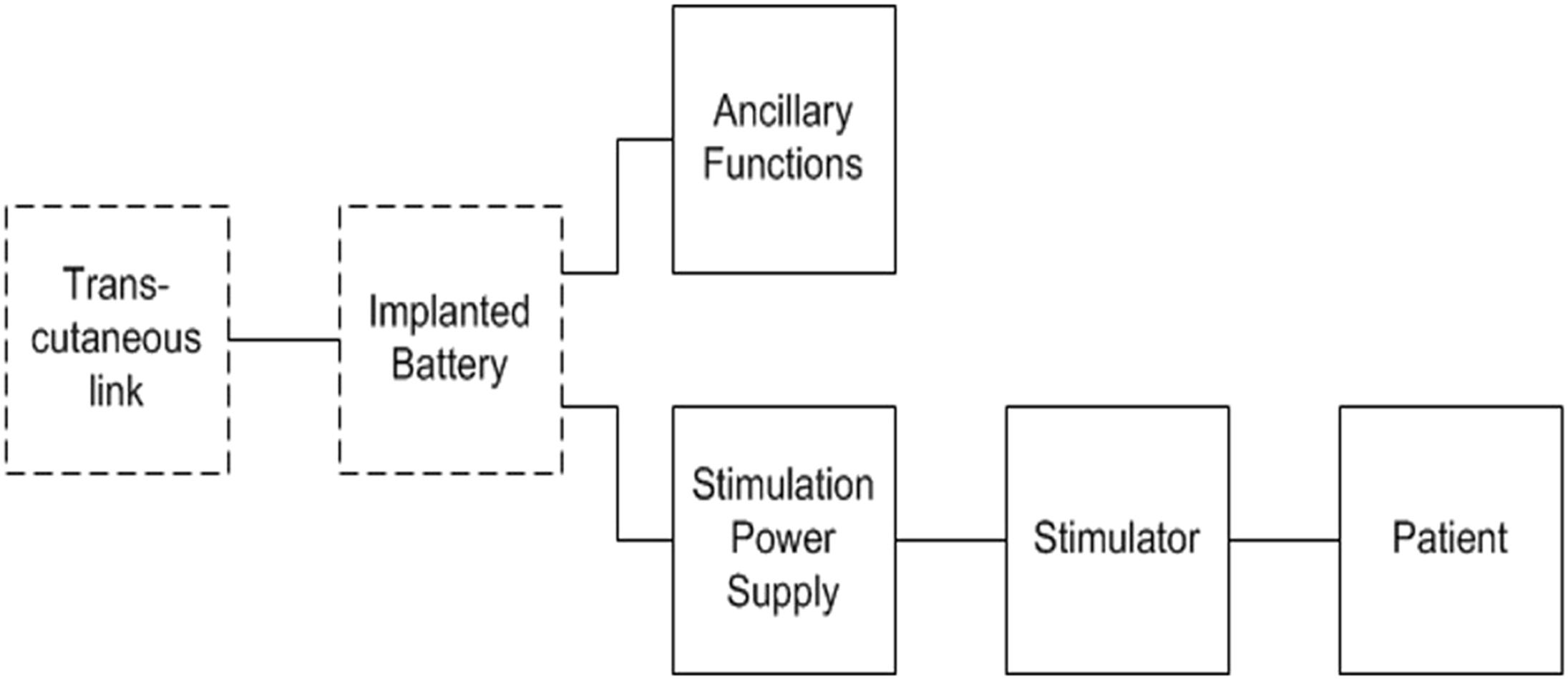
The roles carried out by the ancillary components differ between comparatively simple neuromodulators such as those for SCS and sacral nerve stimulation (SNS), and those for cochlear implants. Fixed-output SCS and SNS devices usually have simple ancillary functions where cochlear implants' ancillary functions can include extensive signal processing. Feedback controlled SCS devices fit in between these two extremes. Cochlear implants have high-power requirements and tend to use external batteries and transcutaneous links, while SCS and SNS devices use implantable batteries.
Useful insights into system power supply performance are obtained by comparing the energy drawn from the battery to the energy delivered to the patient.
The stimulus pulses provided by a neurostimulator typically have a pulse width varying between 6 μs for a Cochlear implant and up to 1000 μs for a spinal cord stimulator [ , ]. They can vary in output current from 10 μA to 50 mA. The upper limit of stimulus energy is set partially by the safe charge limit for the electrode but primarily by the requirements of the specific therapy. The stimulus rate can vary between ∼1 Hz for a cardiac pacemaker and 83 kHz for a cochlear implant. The power consumption depends on the pulse parameter, frequency, and pattern of stimulation. Some typical wave forms used for neuromodulation are illustrated in Fig. 10.2 . A survey of energy per stimulus for different stimulators is shown in Fig. 10.3 .

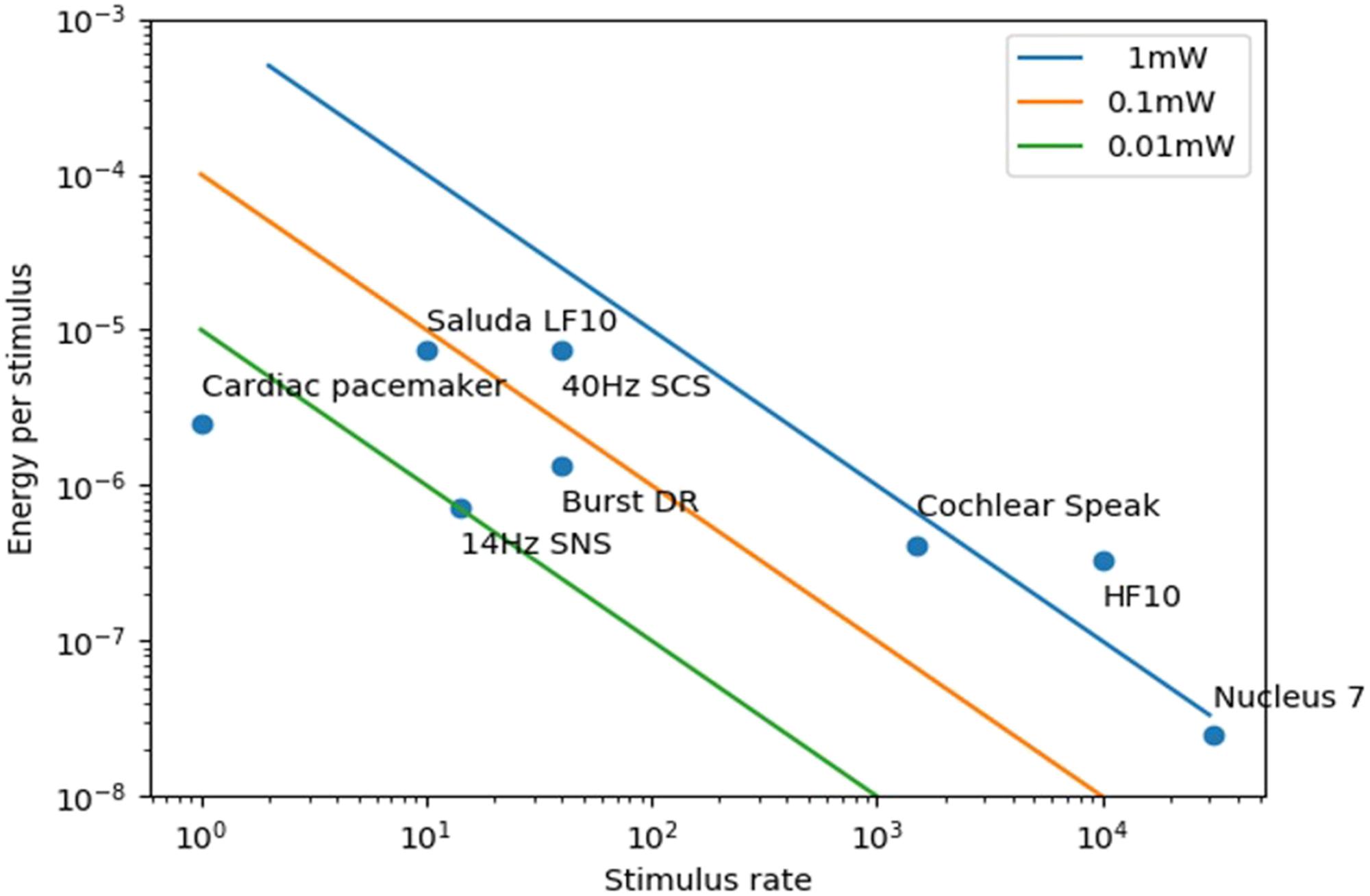
The power delivered to a patient by a neuromodulation device is simply the product of the energy per stimulus and the stimulus rate. At one extreme of the range is the cardiac pacemaker stimulating at 2.5 uJ per pulse at approximately 1 Hz for a power consumption of 2.5 uW. At the other extreme is the HF10 spinal cord stimulator providing 330 nJ per stimulus at a rate of 10 KHz for a power consumption of 3.3 mW.
Stimulus parameters are adjusted with the aim of recruiting fibers which have a relatively narrow range of excitability with smaller diameter fibers being harder to recruit. The distance between the contacts and the fibers also has a significant impact, with closer proximity requiring less energy. For instance, energy required per stimulus varies from 150 nJ for a cochlear implant where the electrode can be within 0.1 mm of the target, and at the other extreme the spinal cord stimulator where, in the thoracic region, the distance from the dorsal column to the electrode is typically 6 mm and 5uJ per stimulus is required.
Batteries are electrochemical cells which convert chemical energy into electrical energy which is released by the metals, oxides, or molecules undergoing the reaction. Batteries consist of voltaic cells which consist of two half cells separated by some electrolyte, anions, or negatively charged species migrate toward the negative electrode and cations migrate toward the positive terminal in the other half cell. The cells are built in such a way that the redox reaction cannot occur without passing current outside the cells and this energy can be used to drive a circuit.
Different battery systems and chemistries are capable of storing different amounts of charge and have different terminal voltages, so their capacity is expressed as Wh/kg or Wh/L, with Fig. 10.4 illustrating differences. For implantable devices, higher energy density will result in smaller devices which is highly desirable. In primary cells, the redox reaction is irreversible and once the chemistry is depleted the cell no longer provides any power. The redox reaction can be reversed in rechargeable batteries.
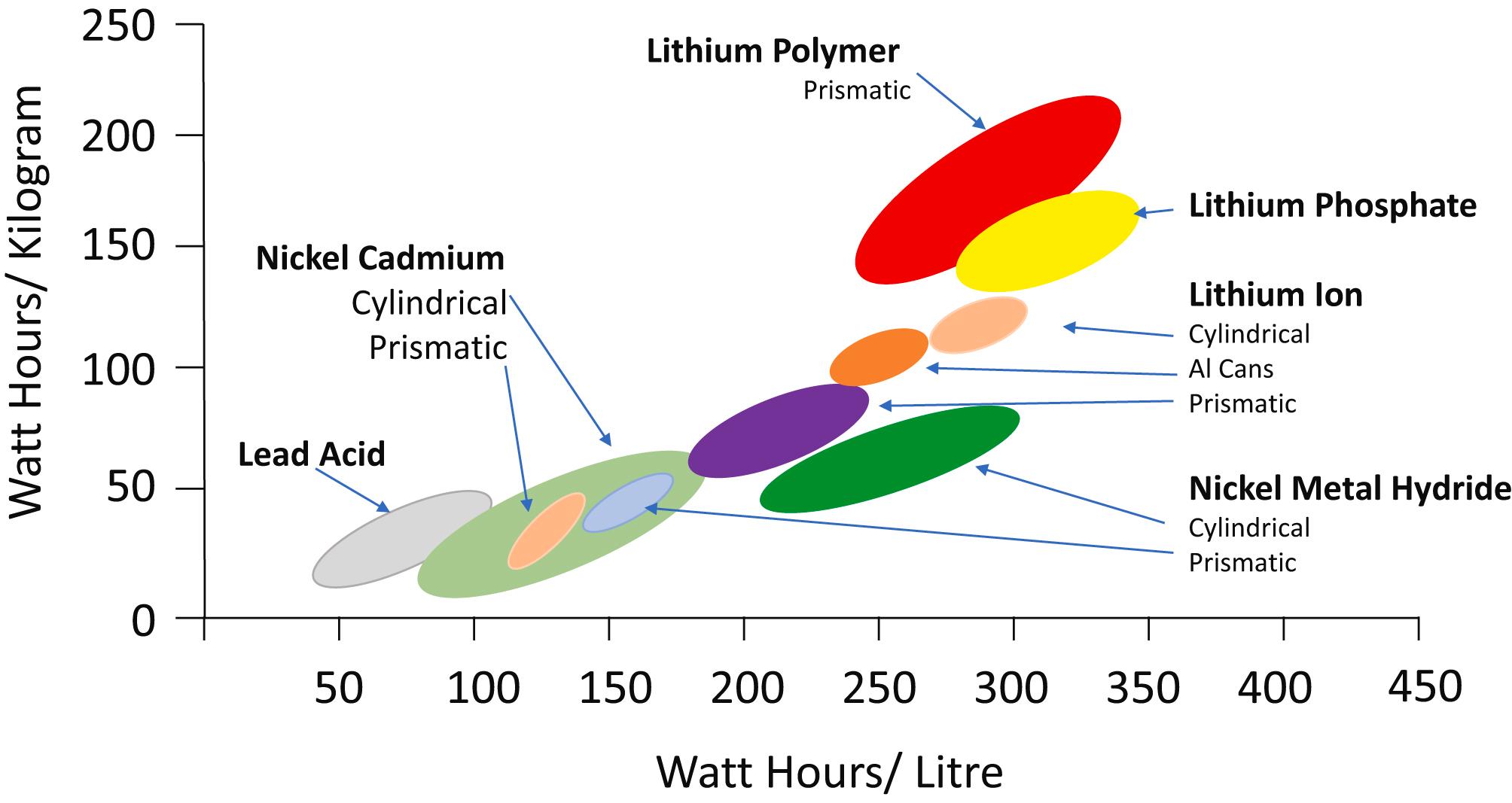
There are a variety of battery systems that have been developed for use with implantable medical devices and the types of cells have been recently reviewed [ ]. Most use lithium metal anodes combined with a variety of cathode systems including iodine, manganese oxide, carbon monofluoride, vanadium oxide.
The theoretical energy densities of primary cells are shown in Table 10.1 .
| Battery system | Open circuit cell potential | Nominal cell potential | Theoretical gravimetric capacity of cathode material (mAH/g) | Theoretical volumetric capacity of cathode material (mAH/cm 3 ) | Theoretical energy density of cathode material (mWh/g) | Energy density of battery (mWh/g) |
|---|---|---|---|---|---|---|
| Li/I 2 | 2.8 | 2.8 | 211 | 1041 | 591 | 210–270 |
| Li/MnO 2 | 3.3 | 3.0 | 308 | 1540 | 924 | 270 (low rate) 230 (high rate) |
| Li/CFx | 3.1 | 3.0 | 865 | 2335 | 2595 | 440 |
| Li/SVO | 3.2 | 3.2 | 315 | 1510 | 1008 | 270 |
| C/LiCoO 2 | 4.2 | 3.9 | 155 | 783 | 601 | 155 |
Due to the requirement for a protective enclosure, connecting wires etcetera production devices will not reach these limits. For example, the Eaglepicher 1.5Ah lithium-thionyl-chloride cell has an energy density of 375 mWh/g and 1078 mWh/cc, admirably within 85% of the most energy dense of Table 10.1 .
Rechargeable batteries can provide extensive service life of neurostimulation devices and enable power hungry algorithms to be developed but they do so at the cost to the recipient of recharging burden.
Lithium is the preferred material for rechargeable cells' cathode material due to its high theoretical storage capacity of 3842 mAh/g and low density 0.534 g/cc. These values should not be taken as the potential limit of a rechargeable cell as they ignore the requirement for the anode, electrolyte, current collector, and separator [ ] without which a cell cannot operate.
The advances in rechargeable battery technology have been spectacular. Lithium ion cells, invented by Yoshino in 1985 [ ], have tripled their energy density from 1990 to 2010 and looks to be plateauing [ ] at just above 600 Wh/L (600 mWh/cc), approximately 60% of what is currently available from complete primary cells. Lithium-ion batteries have enabled many forms of portable technology and have had a huge impact on society earning Yoshino, Whittingham and Goodenough the 2019 Nobel prize for chemistry.
Active implantable medical devices (AIMD) require that batteries be safe for implantation in the body. Since batteries store energy, a fault can potentially lead to exothermic reactions which can cause burns. There are a number of protection mechanisms, some contain a porous separator between the anode and the cathode that melts during overheating, closing the pores and shutting down discharge. Additional devices such as fuses can provide additional protection.
Rechargeable batteries can provide longer service life for implantable devices and over the life of the device deliver substantially more power simply because they can be periodically recharged. The charging discharging process is not perfectly reversible and the capacity of rechargeable batteries degrades over time. Batteries which are cycled to near complete depletion will have much shorter service life than those that are shallow discharged and recharged. The 200 mAh QL0200I battery made by Enersys [ ] retains more than 80% of its original capacity after 500 cycles of charging at 100 mA to 4.1 V and discharging at 100 mA to 2.5 V. More gentle cycling prolongs the life of the battery, more than twice as many cycles results in half the capacity loss.
The cell end-of-life can be usefully defined as the point at which the cell can no longer hold sufficient charge for a full day's use.
Fig. 10.5 shows the case with a cell that retains 85% of capacity at 2000 cycles. If the AIMD manufacturer specified 5 days of use at the start of operation, and we assume linear degradation of capacity with use, from Fig. 10.5 it is possible to extrapolate to the 1 day of use point to 9,400 cycles. The total days of use are proportional to the shaded area which is 55 years and can be calculated from:
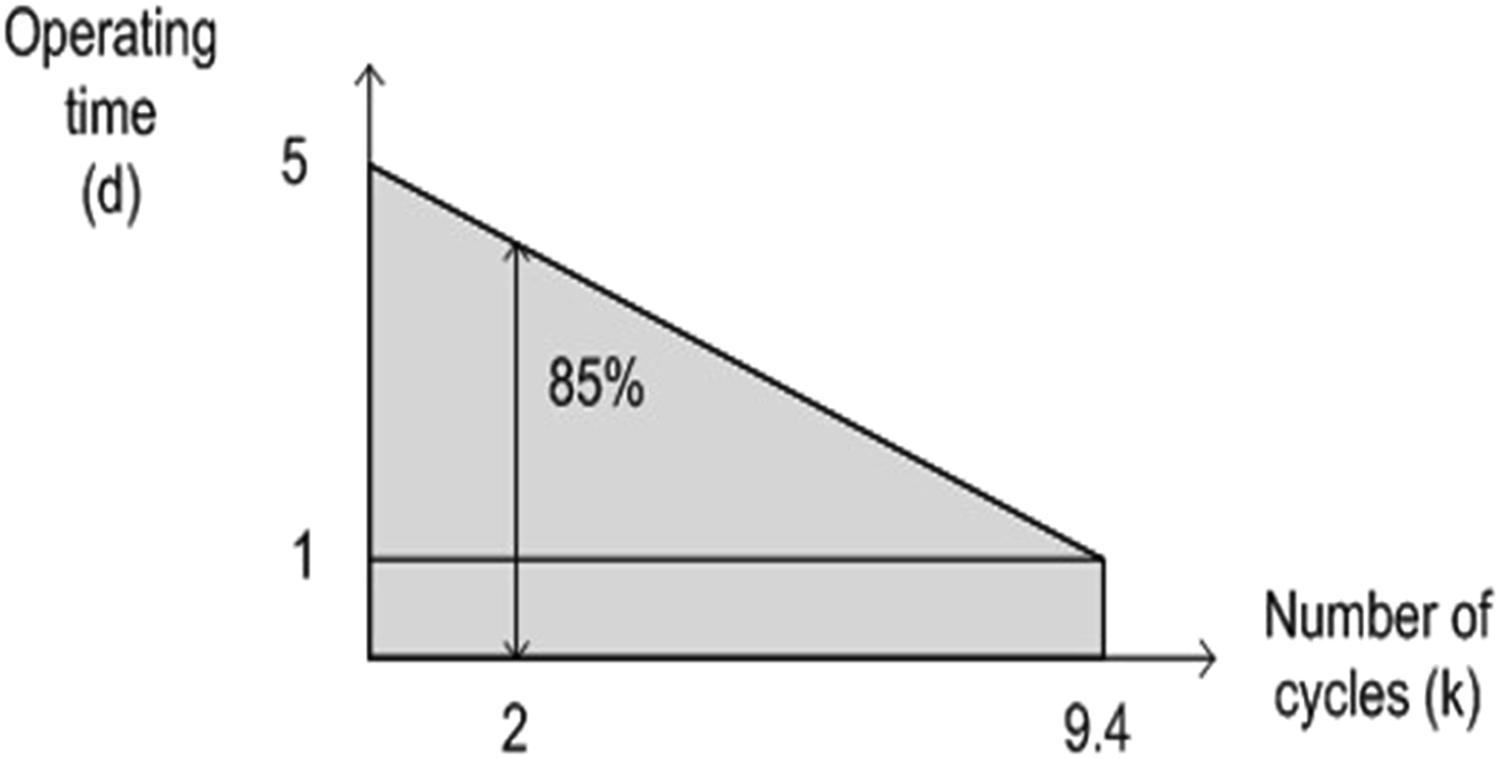
This number is surprisingly high and illustrates the curious interaction between engineering, regulatory burden, and business. Active implantable devices must meet written specifications; to knowingly sell devices that are otherwise, is to sell adulterated product. The cell manufacturer has a problem confirming specifications; accelerated life testing can change the wear-out mechanism of an item, but there is not time to wait 55 years for the test results. Having a specification that is less demanding than individual test items provides a safety margin to accommodate design changes over the product's sales life and batch-to-batch variation. An AIMD manufacturer may also add a safety margin to their specifications to account for variation in the components consuming power from the cell. AIMD manufacturers are also required by medical device standards [ ] to provide an indication to the customer that battery wear-out is imminent. It is a difficult problem to do this based on the cell behavior.
A simple solution to the problem of defining working life is to put a counter in the battery unit, and to render it inoperable after the specified number of recharge cycles. If this is done, the charge the cell will provide during its working life may be decided by business imperative, not science or engineering, and one wonders if such a solution is in the best interest of patients.
To compare rechargeable and primary cells, the total charge the cell will store in its operating lifetime can be calculated and compared to the charge stored by a primary cell of similar volume.
A typical starting capacity for a cell for an SCS device is 200 mAh (QL0200I) (2016), and lithium ion produces and average terminal voltage of 3.7 V, and assuming the cell lasts for just the manufacturer specified period of 1000 cycles, this yields a lifetime working energy capacity
of:
This cell's capacity is 92.5 mWh/g compared to the 600 mWh/g value mentioned previously as the state of the art for rechargeable lithium chemistry. This illustrates the sacrifices that must be made in building a small safe reliable cell. But still, as this cell weighs 8 g, it has a working energy density of 519,000 mWh/g, more than 1000 times that of the available primary cells.
If a neurostimulator uses a rechargeable battery, then a mechanism is required to recharge it. Power can be provided to implanted components using a coil held on the outside of the patient's body that is inductively coupled with a coil in the implant. A similar method may be employed using electric dipoles. Examples of the former include the Bion [ ], cochlear implants, and SCS implant systems, where the Stimwave system uses a dipole [ ]. Inductive links usually operate between 400 KHz and 5 MHz. Dipole systems require a much higher frequency—915 MHz for Stimwave. Not all devices use an implanted battery: Stimwave, the Bion and most cochlear implants rely on transmitted power for operation.
When charging an implanted battery, the link power must be much greater than the stimulus power; the inductive link is the only design that has proven capable of this task and a great deal of work has been done to optimize efficiency [ ]. The battery charge time depends on many factors including the capacity of battery, the extent of recharge required and also the efficiency of coupling of the inductive link.
Inductive coupling employs two coils, one below the skin and one outside the body. These are coupled together to form a transformer. The arrangement can also be used on a continuous basis to power the implant, such as with a cochlear implant with external coil held in opposition to the internal coil using a pair of magnets. In cochlear implants, data are carried with power, though in implants for SCS and SNS, this is not required.
The size of the coils depends on the opposing factors of cosmetics and convenience, which favor a small coil, and link performance which favors a large one. Outside the control of the link designer is the distance between the transmit and receive coils which is usually a result of surgical methods and human anatomy. The greater the ratio of the coil diameter to the coil distance the greater the coupling that can be achieved and so the more efficient the link. As a result of these constraints coils for cochlear implants are usually less than 25 mm and coils for battery charging for SCS are usually around 75 mm. However, even smaller battery charge coils than 25 mm have been achieved [ ].
Due to the range of distances between the transmit and receive coils mis-alignment between the coils is commonplace and adds to the large number of factors that need to be considered in their design. The smallest deepest devices developed so far have been the Bion devices [ ]. A thorough review of the challenges and solutions to powering and communicating with wireless microstimulators for neural prosthetics can be found [ ].
The majority of neuromodulation systems which employ inductive links are of sufficient size to accommodate coils which are several centimetres in diameter. An architectural diagram of such a system can be found in Fig. 10.6 .

The primary transmitting external coil is usually tuned to its resonance frequency for electrical efficiency and the other important factor is the inductance ( L ). The factors for calculating inductance are number of turns, loop radius ( r ) height ( h ) and width ( b ), and wire diameter. From these factors, mutual inductance can be calculated leading to an estimate of the Q or quality factor of the coils and ultimately an understanding of the efficiency of the link. The link can then be tuned using one of the four possible topologies which result from connection of the tuning capacitor to the coil (i.e., serial to parallel, serial to serial, parallel to serial, and parallel to parallel).
The choice between coil or dipole links is partly influenced by the specific absorption rate (SAR) of tissue for a given frequency. Both electrical ( E ) and magnetic ( B ) fields associated with the exposure need to be considered, the internal field in the tissue is dependent on a large number of parameters which include dielectric and geometric properties.
Fig. 10.7 shows the penetration depth of electromagnetic waves at different frequencies. The penetration depth is defined as the depth at which the field strengths or induced current densities have been reduced to 1/e of their initial boundary value. At frequencies below 1 MHz, the penetration depth is above 50 mm but as the frequency is increased it drops considerably. For an electric dipole, there is an inverse relationship between the frequency and the antenna length. The simplest antenna a quarter wavelength is one-quarter of a full wavelength and the wavelength is simply the speed of light over the frequency. The desire to make devices small drives the requirement for small coils and antennas and hence higher resonance frequencies and this only comes with decreases in penetration depth and reduction of efficiency.
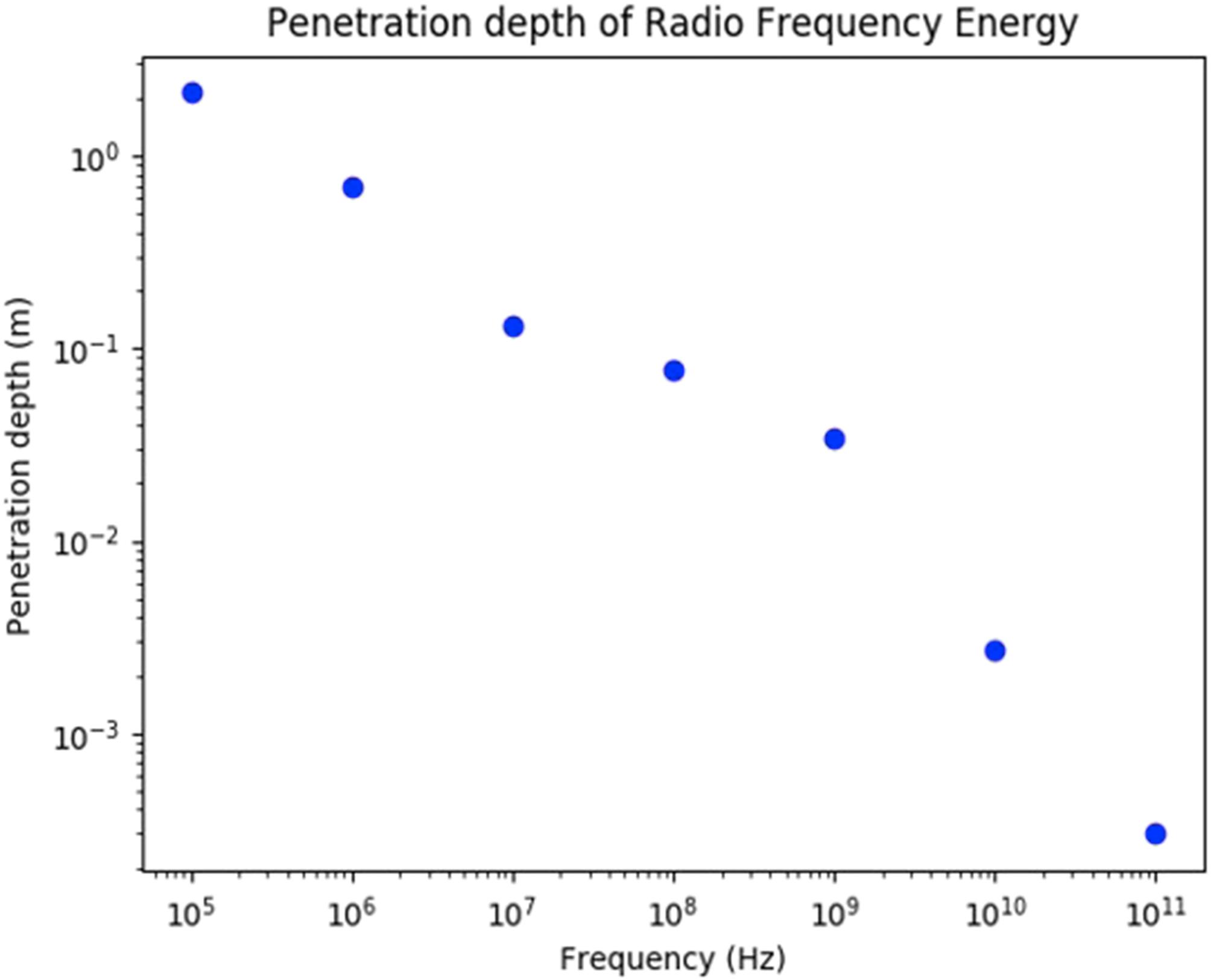
Become a Clinical Tree membership for Full access and enjoy Unlimited articles
If you are a member. Log in here